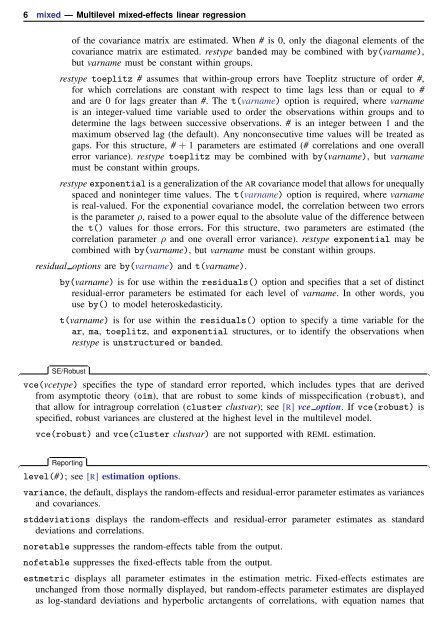mixed - Stata
mixed - Stata
mixed - Stata
You also want an ePaper? Increase the reach of your titles
YUMPU automatically turns print PDFs into web optimized ePapers that Google loves.
6 <strong>mixed</strong> — Multilevel <strong>mixed</strong>-effects linear regression<br />
✄<br />
of the covariance matrix are estimated. When # is 0, only the diagonal elements of the<br />
covariance matrix are estimated. restype banded may be combined with by(varname),<br />
but varname must be constant within groups.<br />
restype toeplitz # assumes that within-group errors have Toeplitz structure of order #,<br />
for which correlations are constant with respect to time lags less than or equal to #<br />
and are 0 for lags greater than #. The t(varname) option is required, where varname<br />
is an integer-valued time variable used to order the observations within groups and to<br />
determine the lags between successive observations. # is an integer between 1 and the<br />
maximum observed lag (the default). Any nonconsecutive time values will be treated as<br />
gaps. For this structure, # + 1 parameters are estimated (# correlations and one overall<br />
error variance). restype toeplitz may be combined with by(varname), but varname<br />
must be constant within groups.<br />
restype exponential is a generalization of the AR covariance model that allows for unequally<br />
spaced and noninteger time values. The t(varname) option is required, where varname<br />
is real-valued. For the exponential covariance model, the correlation between two errors<br />
is the parameter ρ, raised to a power equal to the absolute value of the difference between<br />
the t() values for those errors. For this structure, two parameters are estimated (the<br />
correlation parameter ρ and one overall error variance). restype exponential may be<br />
combined with by(varname), but varname must be constant within groups.<br />
residual options are by(varname) and t(varname).<br />
✄<br />
by(varname) is for use within the residuals() option and specifies that a set of distinct<br />
residual-error parameters be estimated for each level of varname. In other words, you<br />
use by() to model heteroskedasticity.<br />
t(varname) is for use within the residuals() option to specify a time variable for the<br />
ar, ma, toeplitz, and exponential structures, or to identify the observations when<br />
restype is unstructured or banded.<br />
SE/Robust<br />
<br />
vce(vcetype) specifies the type of standard error reported, which includes types that are derived<br />
from asymptotic theory (oim), that are robust to some kinds of misspecification (robust), and<br />
that allow for intragroup correlation (cluster clustvar); see [R] vce option. If vce(robust) is<br />
specified, robust variances are clustered at the highest level in the multilevel model.<br />
vce(robust) and vce(cluster clustvar) are not supported with REML estimation.<br />
✄ <br />
✄ Reporting<br />
level(#); see [R] estimation options.<br />
variance, the default, displays the random-effects and residual-error parameter estimates as variances<br />
and covariances.<br />
stddeviations displays the random-effects and residual-error parameter estimates as standard<br />
deviations and correlations.<br />
noretable suppresses the random-effects table from the output.<br />
nofetable suppresses the fixed-effects table from the output.<br />
estmetric displays all parameter estimates in the estimation metric. Fixed-effects estimates are<br />
unchanged from those normally displayed, but random-effects parameter estimates are displayed<br />
as log-standard deviations and hyperbolic arctangents of correlations, with equation names that
















